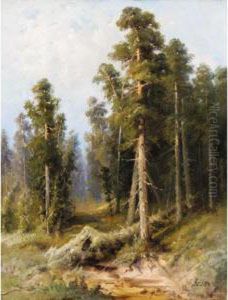Alexander Petrovich Apsit Paintings
Alexander Petrovich Apsit, also known as Aleksandr Petrovich Apsitis, was a prominent Russian and Soviet artist, graphic designer, and illustrator, primarily known for his significant contributions to political poster art, especially during the Russian Civil War period. Born on October 15, 1880, in the town of Jelgava, which was then part of the Russian Empire and is now in Latvia, Apsit demonstrated artistic talent from an early age.
Apsit's early career saw him working in various fields, including as an illustrator for magazines and creating advertisements. However, his work took a dramatic turn with the outbreak of World War I and the subsequent Russian Revolution. The seismic political changes gave rise to a new art form—the propaganda poster—which Apsit embraced with a distinctive style characterized by bold graphics and powerful imagery. His posters were instrumental in conveying Bolshevik messages and played a vital role in political campaigns and revolutionary fervor.
During the Russian Civil War from 1917 to 1923, Apsit produced some of his most notable works. He created over 300 posters that called for the defense of the Soviet state against foreign and domestic enemies, encouraged the masses to participate in the war effort, and promoted the ideas of the revolution. His art was marked by expressive figures, emotional appeal, and often stark, simple messages that could be understood by the largely illiterate population at the time.
After the civil war, Apsit continued to work as a graphic artist but shifted his focus to other areas, including book illustration. His style evolved with the changing times, yet he remained a respected figure in the field of Soviet art and propaganda. Despite the prominence he achieved during his lifetime, Apsit's work, like that of many other artists of his era, became less known after his death.
Alexander Petrovich Apsit passed away on December 19, 1943, in Leningrad, USSR, during the Siege of Leningrad in World War II. His contributions to the art of propaganda, particularly his civil war posters, have earned him a place in art history as an artist who not only documented the tumultuous events of his era but also actively shaped the visual language of his time.
